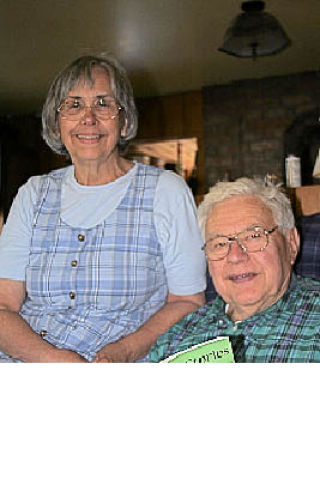Farming, fishing and tiptoeing cows remembered in collection
Add “author” to Shaw Islander Henry Hoffman’s list of professions.
Hoffman is a fifth-generation Shaw Island resident, and he has worked as a farmer, gillnetter and carpenter. He ran a sawmill and rented heavy equipment for his cousin’s earth-moving business and squirreled away scrap metal “I’m a scrap metal pack rat.” He built four homes – the house he grew up in and three since – including his current home on Hix Bay, named after his great-great-grandfather. The cove “next door” is named after Hoffman’s grandfather, who came to the San Juans from Ohio when he changed occupation from accountant to boat-builder to save his eyesight.
Family history is important to Henry and his wife Marlyn. Their children and grandchildren live on the same 40-acre compound, and Hoffman says “They’re in and out of the house all day long, especially when Gramma’s home, always looking for her good cooking.”
Hoffman’s interest in writing began with creative writing courses taught by Janet Thomas. Henry took her memoir-writing class and “Henry’s Stories” was “really intended for the family so the kids wouldn’t lose the stories,” said Marlyn.
At first, Marlyn typed Henry’s stories, and then he got computer software that taught him to type, and “Now it’s a snap!” he says.
In his book, Hoffman describes “the Olden Days” on Shaw of subsistence farming, including hunting and butchering, raising lifestock and going to dances at the Grange where the women talked about kids and babies and men talked about raising chickens. “It is quite a bit different now,” said Henry.
“But it’s still the same community spirit and caring… it’s a little friendlier now and work is better than it used to be.”
Though Henry was born at the outset of the 1930s Depression, he says his family was never hungry. They raised plenty to eat, with livestock such as steer, milk cows, chickens, ducks and turkeys as well as vegetable crops. Fishing and trading with the native Indians supplemented the food shelves.
Henry remembers being lonely as a teenager on Shaw, laying in bed at night, hearing the cars go by. “Instead of dating I would hunt rats in a neighbor’s hen-house, but it’s not as satisfying as going out with a girl,” he says with his typical tongue-in-cheek humor.
His stories about growing up on Shaw are replete with do-it-yourself instructions describing how to build a trailer from a Model A car, retool a car horn motor to fit a wood lathe, fish from spar buoys – and build small explosives and retrofit a hand gun.
“Recycling is nothing new, and it came in handy during the war years,” Henry says.
The book is full of Henry’s puckish sense of humor as he pokes fun, both at himself – “I must have been hard of hearing” (when as a child he ignored his mother calling for him) – his writing – “I’m a poor speller, but with the aid of my spell-checker, I think I can handle the word “rats” so here goes with my attempt at a story about them” – and his times – “The Great Depression … most people didn’t think it was all that great.”’
Henry said that, in telling his stories over the years, “we tend to forget the bad stuff and remember the fun times.”
“And exaggerate them too,” Marlyn says.
He calls his writing schedule “haphazard – I just sit down at the computer, and start typing.” He began with the stories that had been “told and retold” in his family for years. “I don’t know how it happens. You get started and it just leads you someplace. Sometimes it feels like I’ve just taken down dictation.
“I try not to use $10 words. I reread the stories after I’ve written them and remember something funny and make changes.”
His writing has become “more descriptive and more pictorial,” and Marlyn says, “He works at it and he’s grown.” One of the more endearing and amusing anecdotes has to do with the family cow Rosie who followed Henry’s father into a wooded area and then came “tiptoeing out” when he fell down hard. “The expression on her face clearly said, ‘I’m gettin’ outta here! When he gets up, he’s gonna be mad!’”
Henry describes himself as a binge writer: “I love to write; if I sit down at the computer, the day’s gone before I know it.”
In recent years, he joined a writers’ group on Shaw that read and critiqued each others’ work. An earlier edition of the book was produced at Office Depot and the encouragement from local people led Henry to publish his stories in book form. Shavians Sherry Christopherson and Alex MacLeod gave their support, and son-in-law Neal Foley offered to independently publish it through Kitchen Garden Press, which Foley formed when he published his cookbook.
Hoffman’s favorite pastime has been “getting out in the boat and beach-combing – a love I inherited from my father and uncle. He beach-combed the materials he used in building his house: fir framework from the old ferry landing dolphins, cedar for paneling and spruce logs for ceiling timbers. “You could get good logs in those days.”
Henry and Marlyn raised three children – Elizabeth, Kathleen and Michael. Over the years, he served on the Shaw Island Community Organization and as a Fire Commissioner and on the Fire Department. He also sang bass in Mother Kateri’s group in the 90’s.
Since his book came out this spring, Henry says, “It’s been very gratifying to see the positive and encouraging local response.”
Marlyn adds, “People should never be afraid to share their stories – there’s always someone who needs to hear them. So often, our lives touch other people without our knowing how.”




